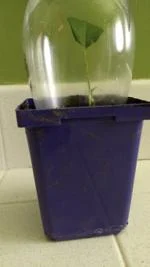Rose propagation isn’t difficult, but requires patience
By Bonnie Orr
WSU Chelan/Douglas County Master Gardener



In November, we had freezing weather before many plants had reached dormancy. Roses were particularly damaged. Grafted roses seemed to suffer more damage than the roses grown on their own roots.
Grafted roses, especially hybrid tea roses, are created when a rose producer connects a desirable rose cane onto hardy roots. You can tell when your prize rose has died back to the root-based rose because the leaves are smaller and darker.
The root-based rose is a dark red floribunda and blooms profusely only once in late spring, and then grows long, floppy canes. Then the root, usually a hardy rose called Dr. Huey, sends out numerous suckers that will overwhelm the desirable roses in the garden.
Some roses, such as shrub roses and miniature roses, are grown on their own roots.
Generally, grandiflora, hybrid tea, some floribundas and climbers are sold as grafted plants. Grafted plants are more susceptible to winter kill in our area.
So why not grow a favorite rose on its own roots? Northland Rosarium near Spokane has made a specialty of growing roses on their own roots. It sells a wide variety of roses.
You, too, can make roses grown on their own roots. This is preferable to attempting to dig up an old, old rose, like from your grandmother’s garden. It will take at least two years for them to bloom.
Make sure the plant you want to propagate is not a patented rose. If you bought it in a pot with a label that provides a specific name, the plant is most likely patented. Some of the classic roses, such as Mr. Lincoln and Chrysler Imperial, are now sold as non-patented roses.
It is easiest to create a new plant with ground layering:
- Take a green stem with no flowers on it.
- Bend the stem to the ground.
- Scrape some of the surface of the stem where it touches the ground.
- Hold the stem in place with a rock or a ground-cover pin.
- Put soil over the pin/rock and the scraped stem.
- Water well.
- Be sure the end of the stem still has its leaves intact.
Within a month, the stem should have rooted. It can be cut from the parent plant at that time.
Also, a new rose can be created with a green stem about the thickness of a pencil:
- Water seed-starting potting soil in a pot.
- Poke a hole 3 inches deep in the soil with a pencil.
- Cut a 6-inch rose stem without a flower or a bud.
- Cut off all but one leaf and the thorns.
- The stem should be trimmed to ¼ inch below a leaf node. Roots grow out of the nodes.
- Dip only the very end of the stem in rooting hormone.
- Slip the stem into the premade hole.
- Press the soil around the stem and water well.
- Cover with a cloche to keep in the moisture. Use something like a Mason jar.
- Place in light but not direct sunlight.
- Do not water again until the soil surface is dry to the touch.
- Be patient.
